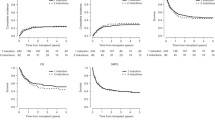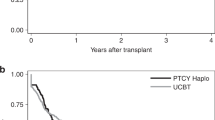Abstract
Reduced-intensity conditioning (RIC) preparative regimens are now widely used in umbilical cord blood (UCB) transplantation. Developed to reduce the rate of transplant-related morbidity and mortality as in adult stem cell donor transplantation, they are becoming more widely accepted. Results from RIC UCB series show a shortened time to engraftment, ranging from 12 to 24 days, with rates of TRM that generally do not exceed the rates seen with myeloablative UCB transplantation. There does not seem to be a convincing trend toward an increase in the rate of malignant relapse after RIC UCB transplantation, despite the lower intensity of the conditioning regimen. In this review, the results from several RIC UCB series are reviewed, comparisons with myeloablative UCB experiences are made and hypotheses regarding the engraftment potential of UCB after RIC regimens are discussed. In addition, a strategy for the optimal use of RIC regimens and UCB transplantation is presented.
This is a preview of subscription content, access via your institution
Access options
Subscribe to this journal
Receive 12 print issues and online access
$259.00 per year
only $21.58 per issue
Buy this article
- Purchase on Springer Link
- Instant access to full article PDF
Prices may be subject to local taxes which are calculated during checkout
Similar content being viewed by others
References
Barker JN, Weisdorf DJ, DeFor TE, Blazar BR, Miller JS, Wagner JE . Rapid and complete donor chimerism in adult recipients of unrelated donor umbilical cord blood transplantation after reduced-intensity conditioning. Blood 2003; 102: 1915–1919.
Brunstein CG, Barker JN, Weisdorf DJ, Defor TE, Miller JS, Blazar BR et al. Umbilical cord blood transplantation after nonmyeloablative conditioning: impact on transplantation outcomes in 110 adults with hematologic disease. Blood 2007; 110: 3064–3070.
Ballen KK, Spitzer TR, Yeap BY, McAfee S, Dey BR, Attar E et al. Double unrelated reduced-intensity umbilical cord blood transplantation in adults. Biol Blood Marrow Transplant 2007; 13: 82–89.
Cutler C, Yeap BY, Kao G, Ho V, Alyea E, Koreth J et al. Double umbilical cord blood transplantation using reduced-intensity conditioning: a single-centre experience. Bone Marrow Transplant 2008; 41: s23.
Rizzieri DA, Long GD, Vredenburgh JJ, Gasparetto C, Morris A, Stenzel TT et al. Successful allogeneic engraftment of mismatched unrelated cord blood following a nonmyeloablative preparative regimen. Blood 2001; 98: 3486–3488.
Misawa M, Kai S, Okada M, Nakajima T, Nomura K, Wakae T et al. Reduced-intensity conditioning followed by unrelated umbilical cord blood transplantation for advanced hematologic malignancies: rapid engraftment in bone marrow. Int J Hematol 2006; 83: 74–79.
Lekakis L, Giralt S, Couriel D, Shpall EJ, Hosing C, Khouri IF et al. Phase II study of unrelated cord blood transplantation for adults with high-risk hematologic malignancies. Bone Marrow Transplant 2006; 38: 421–426.
Okada M, Fujimori Y, Misawa M, Kai S, Nakajima T, Okikawa Y et al. Unrelated umbilical cord blood transplantation using a TBI/FLAG conditioning regimen for adults with hematologic malignancies. Biol Blood Marrow Transplant 2008; 14: 896–903.
Sanz GF, Saavedra S, Planelles D, Senent L, Cervera J, Barragan E et al. Standardized, unrelated donor cord blood transplantation in adults with hematologic malignancies. Blood 2001; 98: 2332–2338.
Majhail NS, Brunstein CG, Tomblyn M, Thomas AJ, Miller JS, Arora M et al. Reduced-intensity allogeneic transplant in patients older than 55 years: unrelated umbilical cord blood is safe and effective for patients without a matched related donor. Biol Blood Marrow Transplant 2008; 14: 282–289.
Laughlin MJ, Eapen M, Rubinstein P, Wagner JE, Zhang MJ, Champlin RE et al. Outcomes after Transplantation of Cord Blood or Bone Marrow from Unrelated Donors in Adults with Leukemia. N Engl J Med 2004; 351: 2265–2275.
Rocha V, Labopin M, Sanz G, Arcese W, Schwerdtfeger R, Bosi A et al. Transplants of umbilical-cord blood or bone marrow from unrelated donors in adults with acute leukemia. N Engl J Med 2004; 351: 2276–2285.
Laughlin MJ, Barker J, Bambach B, Koc ON, Rizzieri DA, Wagner JE et al. Hematopoietic engraftment and survival in adult recipients of umbilical-cord blood from unrelated donors. N Engl J Med 2001; 344: 1815–1822.
Narimatsu H, Watanabe M, Kohno A, Sugimoto K, Kuwatsuka Y, Uchida T et al. High incidence of graft failure in unrelated cord blood transplantation using a reduced-intensity preparative regimen consisting of fludarabine and melphalan. Bone Marrow Transplant 2008; 41: 753–756.
Horowitz ME, Morris A, Gasparetto C, Sullivan K, Long G, Chute J et al. Myeloablative intravenous busulfan/fludarabine conditioning does not facilitate reliable engraftment of dual umbilical cord blood grafts in adult recipients. Biol Blood Marrow Transplant 2008; 14: 591–594.
Komatsu T, Narimatsu H, Yoshimi A, Kurita N, Kusakabe M, Hori A et al. Successful engraftment of mismatched unrelated cord blood transplantation following reduced intensity preparative regimen using fludarabine and busulfan. Ann Hematol 2007; 86: 49–54.
Mancías-Guerra C, Ruiz-Delgado GJ, Manzano C, Díaz-Hernandez M, Tarín-Arzaga LC, González-Llano O et al. Umbilical cord blood transplantation using non-myeloablative conditioning: The Mexican experience. Hematology 2006; 11: 355–359.
Miyakoshi S, Yuji K, Kami M, Kusumi E, Kishi Y, Kobayashi K et al. Successful engraftment after reduced-intensity umbilical cord blood transplantation for adult patients with advanced hematological diseases. Clin Cancer Res 2004; 10: 3586–3592.
Yuji K, Miyakoshi S, Kato D, Miura Y, Myojo T, Murashige N et al. Reduced-intensity unrelated cord blood transplantation for patients with advanced malignant lymphoma. Biol Blood Marrow Transplant 2005; 11: 314–318.
Collis SJ, Neutzel S, Thompson TL, Swartz MJ, Dillehay LE, Collector MI et al. Hematopoietic progenitor stem cell homing in mice lethally irradiated with ionizing radiation at differing dose rates. Radiat Res 2004; 162: 48–55.
Lapidot T, Dar A, Kollet O . How do stem cells find their way home? Blood 2005; 106: 1901–1910.
Liebler JM, Lutzko C, Banfalvi A, Senadheera D, Aghamohammadi N, Crandall ED et al. Retention of human bone marrow-derived cells in murine lungs following bleomycin-induced lung injury. Am J Physiol Lung Cell Mol Physiol 2008; 295: L285–L292.
Xu J, Mora A, Shim H, Stecenko A, Brigham KL, Rojas M . Role of the SDF-1/CXCR4 axis in the pathogenesis of lung injury and fibrosis. Am J Respir Cell Mol Biol 2007; 37: 291–299.
Xu H, Exner BG, Chilton PM, Tanner MK, Mueller YM, Rezzoug F et al. A delay in bone marrow transplantation after partial conditioning improves engraftment. Transplantation 2004; 77: 819–826.
Alyea EP, Kim HT, Ho V, Cutler C, DeAngelo DJ, Stone R et al. Impact of conditioning regimen intensity on outcome of allogeneic hematopoietic cell transplantation for advanced acute myelogenous leukemia and myelodysplastic syndrome. Biol Blood Marrow Transplant 2006; 12: 1047–1055.
Rodriguez R, Nademanee A, Ruel N, Smith E, Krishnan A, Popplewell L et al. Comparison of reduced-intensity and conventional myeloablative regimens for allogeneic transplantation in non-hodgkin′s lymphoma. Biol Blood Marrow Transplant 2006; 12: 1326–1334.
Uchida N, Wake A, Takagi S, Yamamoto H, Kato D, Matsuhashi Y et al. Umbilical cord blood transplantation after reduced-intensity conditioning for elderly patients with hematologic diseases. Biol Blood Marrow Transplant 2008; 14: 583–590.
Kishi Y, Kami M, Miyakoshi S, Kanda Y, Murashige N, Teshima T et al. Early immune reaction after reduced-intensity cord-blood transplantation for adult patients. Transplantation 2005; 80: 34–40.
Chao NJ, Koh LP, Long GD, Gasparetto C, Horwitz M, Morris A et al. Adult recipients of umbilical cord blood transplants after nonmyeloablative preparative regimens. Biol Blood Marrow Transplant 2004; 10: 569–575.
Miyakoshi S, Kami M, Tanimoto T, Yamaguchi T, Narimatsu H, Kusumi E et al. Tacrolimus as prophylaxis for acute graft-versus-host disease in reduced intensity cord blood transplantation for adult patients with advanced hematologic diseases. Transplantation 2007; 84: 316–322.
Author information
Authors and Affiliations
Corresponding authors
Rights and permissions
About this article
Cite this article
Cutler, C., Ballen, K. Reduced-intensity conditioning and umbilical cord blood transplantation in adults. Bone Marrow Transplant 44, 667–671 (2009). https://doi.org/10.1038/bmt.2009.283
Received:
Accepted:
Published:
Issue Date:
DOI: https://doi.org/10.1038/bmt.2009.283
Keywords
This article is cited by
-
Improved survival after single-unit cord blood transplantation using fludarabine and melphalan-based reduced-intensity conditioning for malignant lymphoma: impact of melphalan dose and graft-versus-host disease prophylaxis with mycophenolate mofetil
Annals of Hematology (2022)
-
Impact of 2 Gy γ-irradiation on the hallmark characteristics of human bone marrow-derived MSCs
International Journal of Hematology (2021)
-
Comparison of reduced-intensity/toxicity conditioning regimens for umbilical cord blood transplantation for lymphoid malignancies
Bone Marrow Transplantation (2020)
-
Myeloablative unrelated cord blood transplantation for Philadelphia chromosome-positive acute lymphoblastic leukemia: comparison with other graft sources from related and unrelated donors
Annals of Hematology (2015)
-
Feasibility of umbilical cord blood transplantation with a myeloablative, reduced toxicity-conditioning regimen
Bone Marrow Transplantation (2014)



